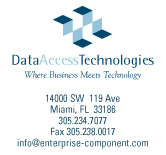

     |
Standards
OMG EDOCDAT has been a major contributor to the OMG's "Enterprise Distributed Object Computing" (EDOC) standard which was just ratified November 2001. EDOC provides the basis for global enterprise computing, integrating the information system with EAI, B2B, Events and information which has been implemented in Component-X. EDOC is the UML based modeling paradigm for enterprise Internet computing More... OMG UML and Model Driven Architecture™UML with MDA provides an open, vendor-neutral approach to the challenge of interoperability, building upon and leveraging OMG's established modeling standards, including Unified Modeling Language. DAT uses these standards to enable the development of reduced time and cost, open system architectures. XML & Web ServicesVarious approaches and technologies have been proposed and developed for enterprise integration. But for integration across the Internet, XML has become recognized as the technology of choice. XML allows businesses, information systems, and applications to be integrated and adapted easily. By agreeing to use XML to implement Web services, by exchanging XML data over the Internet, many of the technical hurtles to integration and collaboration disappear. Business can concentrate on using and publishing XML-based application services and using off-the-shelf tools. XML is an open standards technology. But XML alone is not enough. Open standards are required to securely and reliably send XML over the Internet, as well as to design and construct XML applications from components. These standards are coming out of organizations such as W3C, OMG, ebXML, ISO, and others. The standards make it possible to build Internet enabled solutions that can work immediately with other businesses. The use of standards for tools and infrastructure prevents proprietary lock-in and ensures that an investment in IT assets is a lasting investment. ebXMLebXML goes beyond web services to provide a true business-business collaboration environment based on the secure and reliable exchange of documents between business partners. ebXML defines both the model (Called a BPSS) and transport for electronic business. DAT can help you apply ebXML to your business and has designed Component-X™ with ebXML in mind.
Component-X™ StandardsThe component architecture of Component-X™ is based on standards work with the Object Management Group, ebXML and W3C. Component-X™ implements the Component Collaboration Architecture (CCA) which is a UML profile adopted as part of EDOC and enterprise application integration. Due to the leverage of Component Collaboration Architecture, we expect Component-X™ to become the basis for XML component standards. Component-X™ and the EDOC Component Collaboration Architecture are part of the UML family of languages. Component Collaboration Architecture is defined as a "profile" of UML. A profile of UML specifies a specific way to use UML for a specific purpose. The Component-X™, the purpose is to enable components to collaborate. Component-X™ implements the ebXML business process specification and provides option adapters for integration with the ebXML messaging infrastructure. All information exchange between Component-X™ components is XML data, as defined by W3C. Internally, information is exchanged in "DOM trees," which are W3C standard for in-memory representation of XML data. Component-X™ is implemented in pure Java for portability and adherence to standards. Additional components may be developed in Java by any programmer and the components added to the component pallet. Using Java's capability to call many other computer languages directly and through middleware, Component-X™ components may integrate with almost any external system. Interactions between Component-X™ components within a single program or server is implemented using standard Java events carrying XML data. By using Java as the base component language, we not only ensure portability, but an open system as well. No proprietary "scripting" languages are needed; and the library of component business and technical components can be extended to anything Java can do. Fortunately, the consensus, standards, and the energy surrounding XML has encouraged vendors to produce off-the-shelf tools and infrastructures for assembling and deploying XML-based Internet solutions. Component-X™ tools provide the drag-and-drop component development and assembly environment that helps put together robust and easy-to-use solutions. Component-X™ interfaces with standard Web servers, application servers, DBMS systems, middleware, and tools to provide a complete solution.
|
|
 |
� Data Access Technologies 2001. All rights reserved.
Site designed and developed by Design for
Advantage.